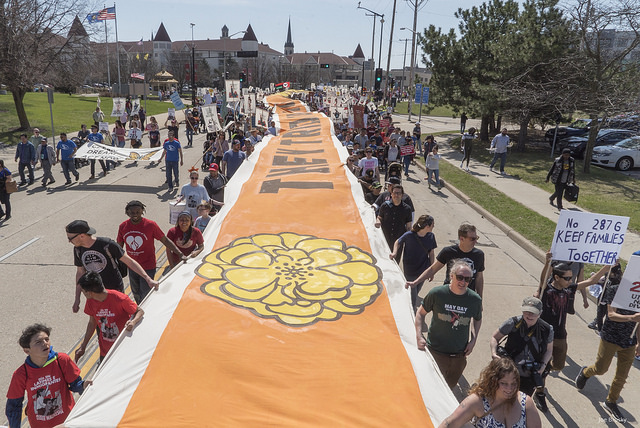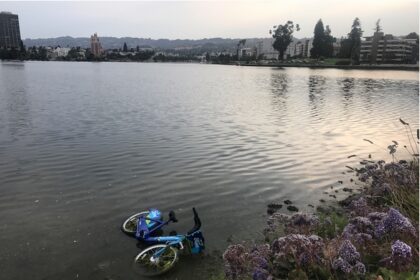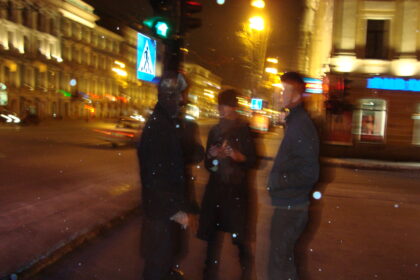Great Lakes Report
Dan S. Wang
Has anybody seen the sturgeon?
That was the gist of Milwaukee artist Susan Simensky Bietila’s social media post in early April of 2018. She was tracking down a trio of papier-mâché fish puppets gone missing. She made them for water protector demonstrations, though my fanciful suspicion was that the fish went AWOL for the purposes of respite, knowing that their workload included numerous appearances: rallies against the routing of oil trains through downtown Milwaukee, and demonstrations opposed to the Back Forty Mine, a proposed open pit metallic sulfide mine.[1] These industrial projects among others are only the latest in a decades-long succession of mining industry threats to the watersheds and indigenous nations of Northern Wisconsin and Michigan’s Upper Peninsula. Such is the multi-front context of struggle in the western Great Lakes region of Northern Illinois, Wisconsin, and Minnesota.
The struggles of the region are by no means confined to those of land and ecology. Black liberation politics aka #blacklivesmatter remain totally urgent, a condition made dramatically clear by the viral recordings of the police execution of LaQuan MacDonald in Chicago and the horrific traffic stop murder of Philando Castile in St. Paul, Minnesota. The state of Wisconsin, not to be outdone in the region’s race to the racist bottom, shamefully features some of the widest racial disparities in the entire nation—and at least two more police murders of unarmed Black men in recent years, Dontre Hamilton of Milwaukee and nineteen-year-old Tony Robinson in Madison. Given the violence routinely enacted by the police and other authorities around these parts, Bietila’s missing-in-action fish puppets could also be read as stand-ins for broken and jailed Black bodies or, as elaborated on below, detained workers.
This belt of the Upper Midwest is rife with political tension, urban-rural divides, and, never to be ignored in anthropocenic scenarios, enjoys some of the most abundant fresh water on the planet. This is the Great Northwest of the mid and late 19th century from which the commodity markets of Chicago funneled lumber, grain, and meat to the rest of the world.[2] Today the region is a continental breadbasket of corn, soy, hogs, and dairy. And, significantly, the Chicago-based trading of commodity futures—that all-important hedging device for speculators around the world—remains a standard gambling platform for the investor class. While Chicago reaps the benefits of its status as a hub of financialization, across the midwestern hinterlands massively globalized agri-extraction proceeds apace. Input-intensive farming and 24/7 electronic trading modernized their respective sectors, but did so while remaining largely shielded from public awareness. Manufacturing—that site of so much Midwestern political conflict—is, of course, a different story. Whole cities as sacrifice zones cannot be swept from view; case in point, Flint, Michigan’s municipal water contamination crisis. Deindustrialization also renders a large segment underemployed and class immobile. This is particularly true for the Midwest’s African American working class, a people descended from Great Migration forebears—many of whom were refugees from the terrorism of Southern lynch mobs. If we add-in the punitive policies of conservative ideology, then the result is a Black population caught in a vise of racist treatment within the region’s majority white society.
The ascension of Trump has produced among other types of chaos a Republican Party that has descended into internecine battles. The casualties are nowhere more profound than the triumvirate of Reince Priebus, Paul Ryan, and Scott Walker, the core of the Wisconsin Republican cabal. Priebus, the wunderkind strategist who facilitated a Republican lock on the formerly progressive state of Wisconsin and then vaulted to national prominence as the leader of the Republican National Committee, took an ill-fated turn as Donald Trump’s first chief of staff, resigning after barely six months. Speaker of the House Ryan, member of the Wisconsin delegation and second in the line of presidential succession, resigned his seat in 2018 at age 49 after a final year of non-stop Capitol Hill drama wrought mostly by presidential tweet. Scott Walker, notorious union-busting governor and third leg of the Wisconsin reactionary trio, was voted out in November. He never recovered from the damage inflicted by Trump early on during the 2016 Republican presidential primaries, essentially crushing his national ambitions for good. These three career conservatives, perched at heights of decision-making power, have proved that they are not equipped to handle the perpetual prime-time reality show that is the Trump presidency.
The Democrats are poised to make gains, but only if they overcome their party’s phobia toward socialistic voices, particularly in the all-important swing region of the Great Lakes. With district maps disfavoring them and a habit of retreating when boldness is the only winning strategy, the Dems may yet find ways to lose. Additional uncertainty stems from the power base of the left being located outside the Party; in recent years the most effectively resistant entities have been the teachers’ unions. The victorious Chicago Teachers Union strike of 2012 can be read as a precursor to the wave of public school teachers union strikes in West Virginia, Oklahoma, Arizona, and most recently Los Angeles. The Chicago teachers, in turn, learned from the mistakes of the Wisconsin teachers unions, who have been heavily wounded ever since 2011. Though the public education constituencies led the mass Wisconsin Uprising of that spring—beginning with a spontaneous wildcat sick-out in several large school districts—in the end they lost, partly, I would argue, due to the union’s unwillingness to call a full-blown work stoppage. A consequence of defeat was the decertification of many bargaining units, significantly blunting Wisconsin’s labor movement.
With the unions pushed aside, the immigrant justice movement has emerged as Wisconsin’s progressive hope. The strategically savvy Milwaukee-based Voces de la Frontera [Border Voices], led by organizer Christine Neumann-Ortiz, has proven itself able to lobby lawmakers, call out demonstrators by the thousands, and roll back local law enforcement initiatives intended to prey on immigrant communities and undocumented families. By coordinating symbolic strikes under the banner of A Day Without Latinos, a cross-sectoral action in 2016 in which Latinx dairy workers walked off the job and flooded the capitol to protest anti-immigrant bills, Voces has brought together the politics of labor and borders. Quick to retweet in support of the teachers, groups battling Islamophobia, and the campaigns against racist police violence, Voces exemplifies next-level rainbow work wherein gestures of solidarity and mutual amplification issue forth as an essential character of the group voice.
Voces stands out also for its visual communication. The organization and its youth section YES (Youth Empowered in the Struggle) have cultivated a roster of visual artists working in its ranks. With youth energy and the dedicated collaboration of highly skilled artists, the art teams of Voces have successfully trained themselves to embellish their mass mobilization events as graphically-enhanced performances. Following the 2016 election/farce, the artists allied with Voces organized themselves into an artist-affinity subgroup modeled on Gran Fury’s semi-autonomous work in service of ACT UP from a generation ago. Called Voces de los Artistas, the affinity group was initiated by Milwaukee-based artist Nicolas Lampert. With fifty-some local artists on-call, as with Gran Fury of old, this group can ring in squads to design, print, paint, and assemble signage on short notice for Voces actions. In addition to Lampert, the art squad includes Pete Railand and Paul Kjelland.[3] Other regular contributors include Claudio Martinez, Jeanette Arellano, Ceci Tejeda, Danny Torres, as well as Susan Simensky Bietila, Raoul Deal, Kim Cosier, Josie Osborne, and the photographers Joe Brusky, Susan Ruggles, and Barbara Miner.

With this well-practiced team Voces turns out arguably the most consistent protest aesthetic of any grassroots group in the nation. Movement photographers are always in attendance, ready to document and flood social media as actions unfold, amplifying campaigns in real time. For May Day of last year, Voces brought out ten thousand marchers for a demonstration and celebration of migrant labor, sited purposefully in the city of Waukesha, ground zero of Wisconsin’s fascist reaction. In their latest assault, the conservatives of Waukesha County have granted Sheriff Severson the right to deputize his officers with the authority of ICE agents, in accordance with Trump’s anti-immigrant 287(g) program. Making use of their massed bodies, marchers unfurled an epic 10-foot wide, 100-yard long banner, turning the street into a flowing message of persistence apropos facing down Trump’s wannbe brownshirts: THEY TRIED TO BURY US, THEY DIDN’T KNOW WE WERE SEEDS. The message, by now familiar at protests in the Age of Orange, was freshened by the sight of children running the road underneath the sheet suspended by the literal arms of solidarity.

In a region with no shortage of politically-committed cultural workers confronting power, the work of Voces de los Artistas stands as exemplary. The machine-like production and deployment capacity of their art dispenses with the bourgeois regime of authorship and professional credit that vexes too many social practice artists. Their screen-genic graphics embedded in well-timed actions collapse performance, protest, documentation, and dissemination into unitary events as a matter of course. As an example, take their lobbying campaign regarding Wisconsin’s Assembly Bill 190, a law that would authorize local law enforcement to question people about their immigration status and detain people as deputized agents of ICE. Voces organized a testimonials lineup of immigrant advocates and the dairy farmers that depend on them. They testified to the harmful effects of AB 190 against the backdrop of a Voces de los Artistas produced banner that read GOT MILK? NOT WITHOUT IMMIGRANTS, the text flanked by the familiar graphic milk carton. Then Voces activists handed out to lawmakers empty milk cartons bearing the same text. Theirs was a self-reinforcing message delivered through personal voices as well as graphically, one that spelled out the reality of the modern dairy economy for legislators still enthralled by their state’s Dairyland heritage.
In 2019 grassroots political resistance must counter the most unconsciously code-fluent and teleperformative fascist leader ever, as well as the forces of capital riding his chaos. In the western Great Lakes region, Voces and its artists are doing just that. Weeks after her plea for their return, Bietila found her puppets and put them right back to work. May the eggs of every paper sturgeon hatch ten thousand disobedient borderless water protectors.
Thanks to Nicolas Lampert for fact checking and advisement.
Dan S. Wang/王念華 is an artist and writer whose work addresses a range of social movement concerns. Turning politically engaged as a teenager, his activist history includes experience across a variety of grassroots causes: organizing for ACORN, clinic escorting, antiwar agitation, and more. His writings have been published internationally, including the collaborative texts The Social Practice That Is Race co-authored with Anthony Romero, published by Wooden Leg Press, and the critical essay “In the Back of the Beyond” in Global Activism from MIT Press, co-authored with Sarah Lewison. He has lectured widely, including at the Central Academy in Beijing, Documenta 11, and the Third Creative Time Summit, where he delivered a report on the Wisconsin Uprising to a global art audience. New projects for 2018 include commissions from Asian Arts Initiative in Philadelphia and Station Museum of Houston.
Notes:
[1] The oil trains are eastbound and southbound trains of the notoriously unsafe DOT-111 tank cars bearing unstable crude oil “fracked” out of the Bakken Shale of North Dakota.
[2] The taming of the West via the extraction and marketization of lumber, grain, and meat is described by William Cronon in his environmental history of Chicago, Nature’s Metropolis.
[3] Lampert, Railand, and Kjelland are members of the Just Seeds collective, an organization of political printmakers and graphic artists.










